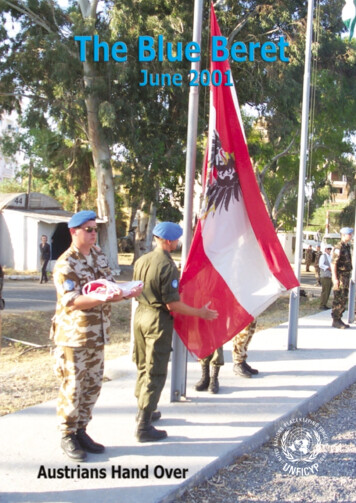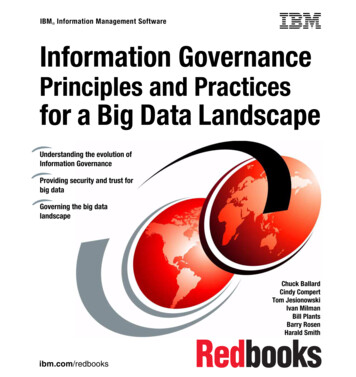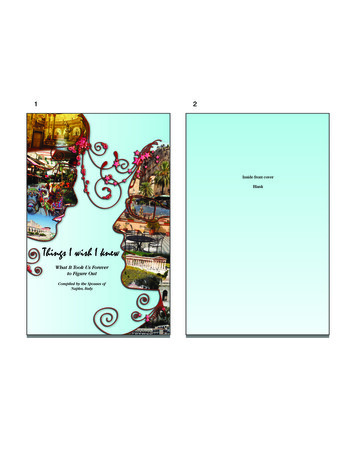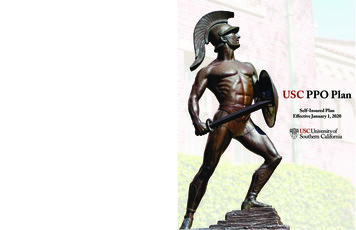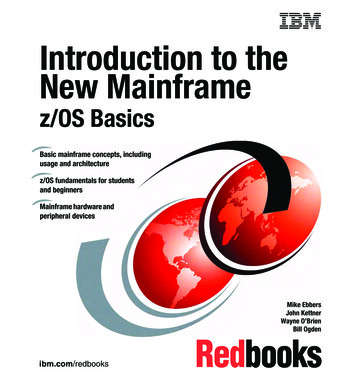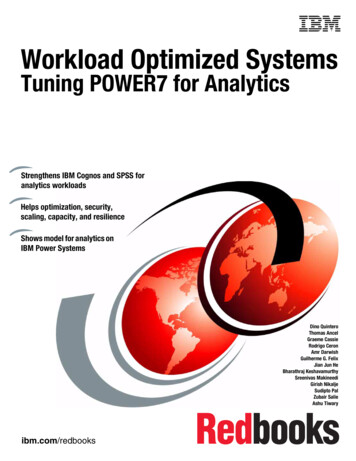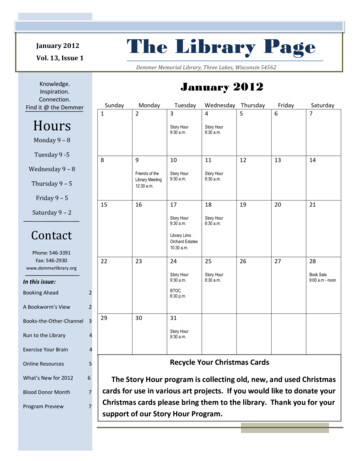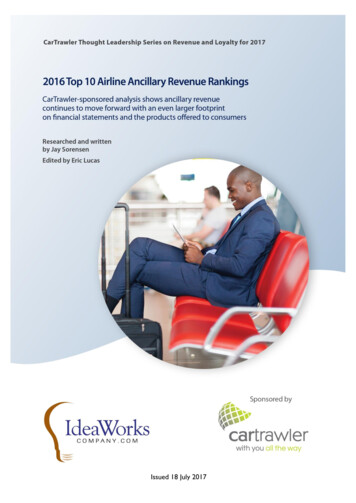![[Page 1 – Front Cover] [Show Cover CLEAN GET- AWAY 978-1 .](/img/13/9781984892973-6648.jpg)
Transcription
NEW YORK TIMES BESTSELLING AUTHOR OF DEAR MARTIN“A book that deserves tobe eaten by young people!”—CHRISTOPHER PAUL CURTIS,author of Newbery Medalwinner Bud, Not Buddy[Page 1 – front cover][Show cover CLEAN GETAWAY 978-1-9848-9297-3]Educators’ GuideCROWNE D U C ATO 1R S’ G U I D E
ABOUT THE BOOKFrom New York Times bestselling authorNic Stone comes a middle-grade road-tripstory through American race relations past andpresent that is perfect for fans of JacquelineWoodson and Jason Reynolds.How to Go on an Unplanned Road Tripwith Your Grandma: Grab a Suitcase: Prepacked from the bigspring break trip that got CANCELED. F asten Your Seat belt: G’ma’s neverconventional, so this trip won’t be either. Use the Green Book: G’ma’s most treasuredpossession. It holds history, memories, andmost important, the way home.What Not to Bring:Grades 3–7 HC: 978-1-9848-9297-3GLB: 978-1-9848-9298-0 EL: 978-1-9848-9299-7CD: 978-0-593-15538-7 DN: 978-0-593-15539-4 A Cell Phone: Avoid contact with Dad at allcosts. Even when G’ma starts acting strangerthan usual.Set against the backdrop of the history of segregation in the American South, take a tripwith New York Times bestselling author Nic Stone and Scoob, an eleven-year-old boy whois about to discover the world hasn’t always been a welcoming place for kids like him,and things aren’t always what they seem—his G’ma included.ABOUT THE AUTHORNic Stone is an Atlanta native and a Spelman CollegeNIGEL LIVINGSTONEgraduate. After working extensively in teen mentoring andliving in Israel for several years, she returned to the UnitedStates to write full-time. Nic’s debut novel for youngadults, Dear Martin, was a New York Times bestseller andWilliam C. Morris Award finalist. She is also the authorof the teen titles Odd One Out, a novel about discoveringoneself and who it is okay to love, which was an NPR Best Book of the Year and aRainbow Book List Top Ten selection, and Jackpot, a love-ish story that takes a searinglook at economic inequality and which School Library Journal calls “a real winner.” CleanGetaway, Nic’s first middle-grade novel, deals with coming to grips with the pain of thepast and facing the humanity of our heroes. Nic lives in Atlanta with her adorable littlefamily. Find out more at nicstone.info.2
Responses to these questions can be shared orally, in writing, or in another medium.The educator may select the appropriate medium for each response.BEFORE READING QUESTIONS AND ACTIVITIES:1. What is your nickname? How did you get that nickname? If you do not have anickname, imagine one for yourself, and create an origin story for it.2. Look at the cover of Clean Getaway. What do you think this book is about?What questions are sparked by this cover?3. Look at the state map of Alabama before chapter 1. Create a similar map for yourstate or hometown. What places, events, people, or other things do you highlight?Why did you include these items? What did you exclude?4. What does guilt look like? Create a visual representation of guilt.5. Have you ever tried to make amends after disappointing someone or hurting theirfeelings? What did you do to earn their forgiveness?DURING READING QUESTIONS AND ACTIVITIES:1. Who is the narrator? What is his nickname? How did he come to be called that?(pp. 2–3)2. Readers meet Scoob early in chapter 1. What is your initial impression of him? Whydo you feel this way? What is your initial impression of G’ma? Why?3. Scoob says that the RV gives him “the willies.” (p. 9) Why does Scoob feel this way?He misses G’ma’s house. Why do we become attached to places? Is it really aboutthe place?4. Scoob is in trouble with his father. Why? What happened at school? What do youthink Scoob’s father means when he says, “the punishment is harsher and the falloutis infinitely worse”? Who are “boys like you”? (pp. 13–17)5. Who is Shenice? Who is Drake? What is epilepsy?What do you think about how Scoob responded3Art 2019 by Dawud Anyabwileto Bryce bullying Drake? (pp. 11–15)
DURING READING QUESTIONS AND ACTIVITIES:6. Research the Travelers’ Green Book. Why was such a brochure necessary when G’maand G’pop were young adults?7. Why do you suppose G’ma is swapping the license plates on the RV? (pp. 43–44)8. What is at the intersection of Sixteenth Street and Sixth Avenue in Birmingham,Alabama? What happened there? Why is it significant? (pp. 51–53)9. G’ma keeps calling Scoob “Jimmy.” Why? Who is Jimmy? What do you think ishappening to G’ma? (pp. 82–83)10. Scoob believes that G’ma is being less than truthful with him because she starts towhistle. How do you know if someone is being dishonest with you? What can you doabout it?11. G’ma is overwhelmed with guilt. Why does she think that being pulled over withG’pop was her fault? (pp. 135–136)12. Chapter 15 details Scoob’s dream about being back at home with his dad. What doyou think this dream means?13. In Shreveport, Louisiana, Scoob and G’ma go to a gas station. While there, Scoobbecomes upset. What happens to cause his distress? (pp. 163–164) Have you heardany other stories of people of color being surveilled? What are some consequences ofsuch scrutiny?14. Reread chapter 19. Why is G’ma overcome with guilt? How do you feel about herconfession? Would you forgive her? Are her choices justified? Explain your thinking.15. Describe the reunion of Scoob and his dad.16. Why do you think Scoob’s mom is out of his and his father’s lives? Why do you thinkScoob is not ready to reconnect with her? (p. 216)17. What does Scoob find inside G’ma’s treasure chest? What do its contents inspireArt 2019 by Dawud AnyabwileScoob and his dad to do?4
Research these key moments, terms, and people:Medgar Evers: W ho was he? What did he do? W hy was his murder a key moment in the civil rights movement? (p. 128) When was his killer convicted? Why did it take so long? What does this tell you aboutthe justice system? H ow have Evers and his contributions to civil rights been memorialized?Loving v. Virginia (Supreme Court of the United States case): What was decided by this case? (pp. 128–129) W hy was this a landmark decision?Emmett Till W ho was he? What happened to him? Why do you think his mother, Mamie Till, insisted on an open casket? Have there been any recent developments in this case? What do you think about them? R ead the book A Wreath for Emmett Till by Marilyn Nelson. Listen to this NPRinterview: npr.org/templates/story/story.php?storyId 4818586. Create a visualresponse.Sundown Towns W hat is a sundown town? H ow did the Green Book help people navigate sundown towns?Ruby Bridges (pp. 162–163) Who was Ruby Bridges? How did she come to play such an important rolein the desegregation movement? Look up Norman Rockwell’s painting The ProblemWe All Live With. What does it depict? How does itmake you feel?5Art 2019 by Dawud Anyabwile D oes this practice continue to this day? How? Why?
AFTER READING QUESTIONS AND ACTIVITIES:1. Reflect on the following quotes:a. “Looks like we’re both trying to make a run for it.” (p. 48)b. “It’s possible to know too much about the folks in your life.” (p. 77)c. “So people don’t have to enjoy the wrong they’re doing to do it?” (p. 85)d. “Man, I hate this world sometimes.” (p. 136)e. “They get seventeen more days. Most of them good.” (p. 211)2. Guilt is a recurring theme in this book. How does guilt motivate G’ma? How doesguilt affect Scoob?3. What is your opinion of G’ma? Was she a good person? Explain the multiple facets ofher character. Is anyone all good or all bad?4. What are some lessons or universal themes in this book? Did it make you think aboutanything in a new way? What? And why?5. What are your thoughts about the relationship between G’ma and G’pop? Do youagree with her choice to not bring their son to visit G’pop in prison? Do you agreewith her choice to keep secrets from her son? Reflect on this relationship.6. Do you think Scoob will ever tell his dad about what G’ma confessed to him? Why orwhy not?7. What realization does Scoob come to when he says, “I’m sorry you lost your mom.”(p. 215) Do you think kids sometimes forget their parents are people, too?8. What do you think of Scoob’s decision to bury G’ma’s treasure box in Mexico? Whatwould you have done?The Common Core State Standards can be used to shape discussions and activities inspired by Clean Getaway.Because literacy classrooms encourage reading, writing, speaking, and listening each day, the following CommonCore State Standards can be used:College and Career ReadinessAnchor Standards for RACY.CCRA.R.9CCSS.ELA-LITERACY.CCRA.R.10College and Career ReadinessAnchor Standards for .CCRA.W.4College and Career ReadinessAnchor Standards for Y.CCRA.L.4College and Career Readiness AnchorStandards for Speaking and ACY.CCRA.SL.4This guide was created by Shanetia Clarke, associate professor of literacyat Salisbury University in Salisbury, Maryland.6
“Powerful, wrenching.”—John Green, #1 New York Times bestsellingauthor of Turtles All the Way Down“Raw and gripping.”—Jason Reynolds, New York Times bestsellingcoauthor of All American Boys“Absolutely incredible, honest,gut-wrenching. A must-read!”—Angie Thomas, #1 New York Times bestsellingauthor of The Hate U GiveH “Essential reading.”—Booklist, starred review“Stone challenges stereotypical notionsof what it means to be straight, bisexual,or gay, showing how sexual identitiesand desires can be as complicated as theindividual human brain.”—Publishers Weekly“Hard-to-put-down, enjoyable read.”—Booklist“Stone delivers a thoughtful andpolished novel about class, privilege,and relative poverty.”—Kirkus Reviews“This is a real winner.”—School Library Journal7
H “An absolute firecracker of a book.”—Booklist, starred reviewH “A heartwarming, family-centered adventurethat will leave readers guessing until the end.”—Publishers Weekly, starred review“Rich in history, Stone’s middle-grade debut entertainsand informs young readers. . . .A road trip to remember.”—Kirkus Reviews“A gratifyingly complex and rewarding story. . . .A book that deserves to be eaten by young people!”“Laced through with smart, sharp humor, quotable dialogue, andpitch-perfect, kid-friendly VOICE for days, Clean Getaway doesn’tflinch in the face of complexity, but depicts an authentic world withrichness, depth, and ultimately joy. This book is a treasure!”—Olugbemisola Rhuday-Perkovich, coauthor of Two ndomSchoolHouseArt 2019 by Dawud Anyabwile—Christopher Paul Curtis, Newbery Medal–winning author of Bud, Not Buddy
Why do you feel this way? What is your initial impression of G’ma? Why? 3. Scoob says that the RV gives him “the willies.” (p. 9) Why does Scoob feel this way? He misses G’ma’s house. Why do we become attached to places? Is it really about the place? 4. Scoob is in trouble with his father. Why

